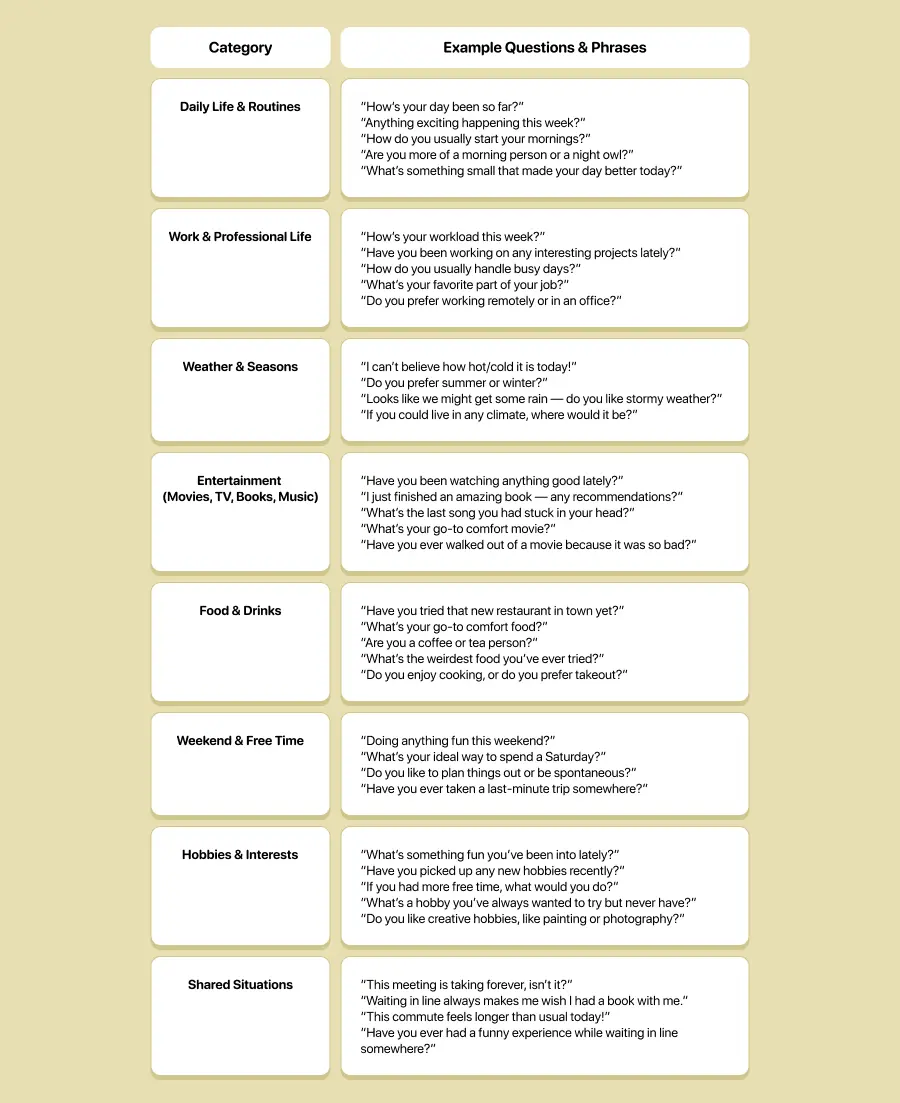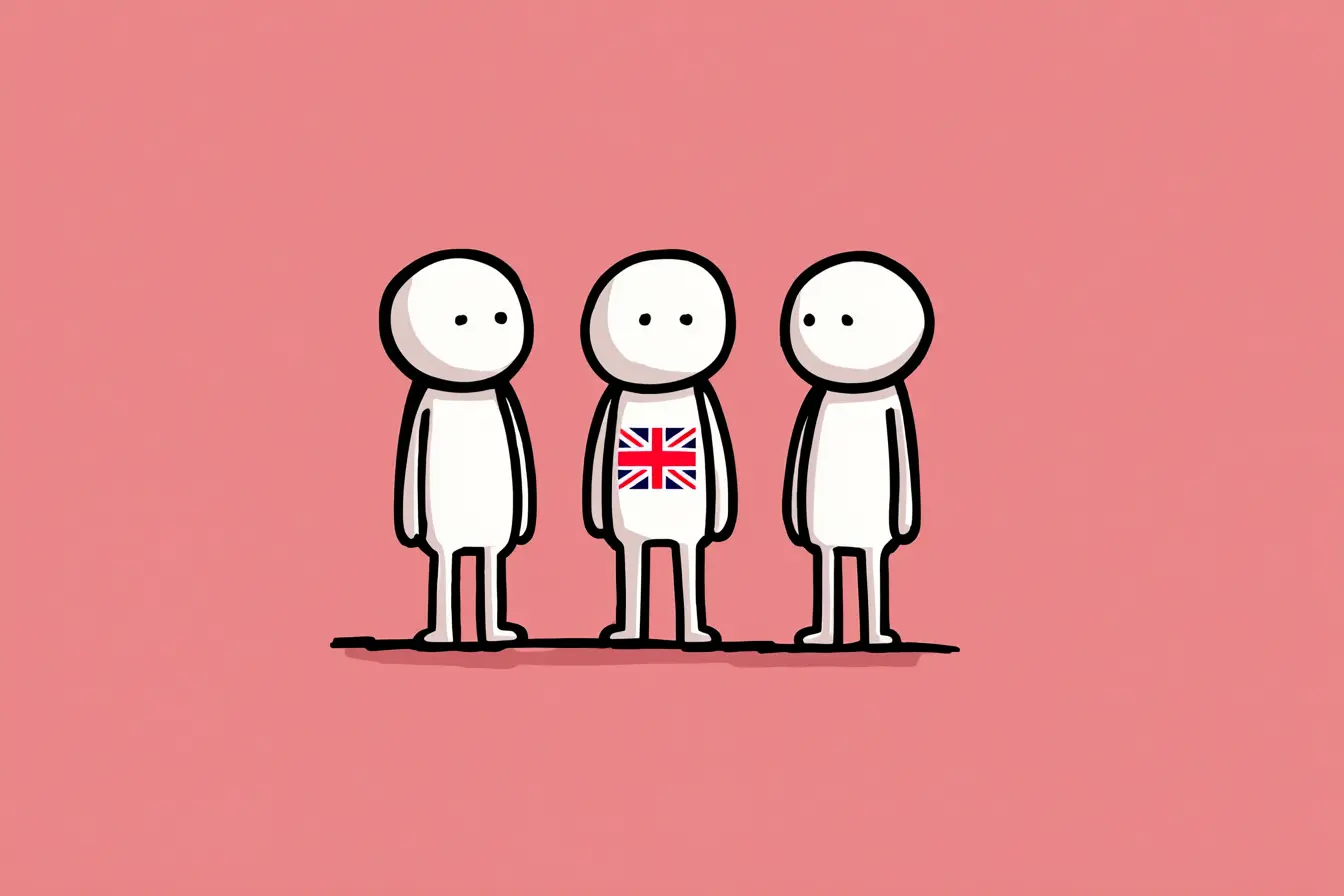Small talk is often dismissed as meaningless chatter, but in reality, it's one of the most powerful social skills you can develop.
Whether you're chatting with a coworker before a meeting, exchanging pleasantries with a neighbor, or filling a quiet moment with a friend, small talk is a bridge to deeper conversations and stronger relationships.
Yet, many people struggle with it because they don’t know what to say to start a conversation or how to keep it going. This guide will show you how to:
- Make small talk effortless in everyday situations.
- Use good small talk questions that feel natural.
- Keep the conversation flowing without awkward silences.
By the end, you'll see small talk not as a chore, but as an opportunity to connect with people more easily.
Small Talk vs. Meaningful Conversation
Small talk isn’t about discussing life’s deepest topics — it’s about creating warmth and connection in everyday moments. Here’s how it differs from deeper conversations:

Small talk isn’t meaningless — it’s a foundation. Mastering it makes it easier to navigate both social and professional situations with confidence.
Examples of the Best Small Talk Topics for Any Situation
Having a few go-to topics to talk about helps you avoid those dreaded awkward silences. Here are some interesting things to talk about.

The best small talk topics are relevant, light, and easy to engage with.
Small Talk Examples in Everyday Conversations
Small talk happens in all types of relationships — with coworkers, neighbors, casual acquaintances, and even family. Here’s how it naturally plays out in different situations.
✅ With a Coworker at the Office
— You: “It’s already Wednesday—this week is flying by.”
— Them: “I know! I feel like I haven’t caught up since Monday.”
— You: “Same here. Have you had time to get to that new project yet?”
🔹 Other variations:
- “I could really use another coffee. Have you tried that new café nearby?”
- “This meeting feels like it might go long. Did you catch the game last night?”
- “Your workspace always looks so organized. Do you have a system for keeping things neat?”
✅ With a Friend You Haven’t Seen in a While
— You: “It feels like forever since we last caught up! What’s new with you?”
— Them: “Work has been crazy, but I finally booked a vacation!”
— You: “That’s great! Where are you going?”
🔹 Other variations:
- “I was just thinking about that trip we took last summer—such a great time.”
- “Have you been up to anything fun outside of work?”
- “What’s something exciting that’s happened since we last talked?”
✅ With a Neighbor
— You: “I think we finally made it through the worst of the winter.”
— Them: “I hope so! I’m ready for some warmer weather.”
— You: “Me too! Do you usually do any gardening in the spring?”
🔹 Other variations:
- “I saw you walking your dog the other day—what’s their name?”
- “Your front yard looks great! Did you do all the landscaping yourself?”
- “Are you going to the neighborhood barbecue this weekend?”
✅ A Shared Situation (Waiting in Line, Commuting, etc.)
— You: “This line is moving slower than I expected.”
— Them: “Right? I thought I’d be in and out.”
— You: “At least it’s giving me time to check my messages. Do you usually come here?”
🔹 Other variations:
- “I always end up picking the slowest checkout line—every time!”
- “The morning commute is never fun, but at least today’s weather is nice.”
- “I forgot how crowded this place gets on weekends.”
How to Keep the Conversation Going Naturally
Starting small talk is easy, but how do you keep the conversation from fizzling out? The key is to make the interaction feel natural and engaging rather than forced or awkward.
To do this, try using two simple conversation techniques: the 3R Method and the LOOP Method.
The 3R Method – Keep Conversations Engaging and Dynamic
- Repeat – Echo part of what the other person said to show interest and encourage them to elaborate.
- "Oh, you love hiking? Where’s the best place you’ve been?"
- Relate – Share a personal experience or opinion to create a sense of connection.
- "I just started hiking too. My last trip was to Yosemite."
- Redirect – Move the conversation forward by introducing a related topic.
- "Speaking of outdoor adventures, have you ever gone camping?"
This method ensures that the conversation stays interesting and doesn’t stall.
The LOOP Method – A Foolproof Way to Keep Conversations Flowing
If you often struggle with what to talk about with people, the LOOP Method is a great tool to keep the discussion alive.
- Listen actively – Pay attention to what the other person is saying and respond accordingly.
- "That sounds amazing. How did you get into that hobby?"
- Open-ended questions – Encourage longer answers to avoid dead-end replies.
- "What’s the most exciting thing that happened to you this week?"
- Offer something about yourself – Don’t just ask questions; share a bit about yourself too.
- "I love trying new coffee places too. Have you ever been to that new café downtown?"
- Personal connection – Find common ground to keep the conversation engaging.
- "I totally get that. I had a similar experience when I traveled last year."
When you combine both the 3R and LOOP Methods, you will always have a way to keep conversations moving and make them more engaging and enjoyable.
Mastering small talk isn’t just about avoiding awkward silences — it’s about building connections in everyday moments. Whether you’re catching up with a friend, chatting with a coworker, or meeting someone new, knowing what to talk about with people makes interactions smoother and more enjoyable. The more you practice, the easier and more enjoyable small talk will become!
FAQ
How do I make small talk feel more natural and less forced?
Many people worry that small talk feels scripted or unnatural. The key is to focus on genuine curiosity rather than trying to impress. Instead of thinking about what to say next, listen carefully and respond with follow-up questions that show interest. Also, using techniques like the LOOP Method can make conversations flow effortlessly.
What should I do if the other person gives short or unengaged answers?
If someone is giving one-word responses or not engaging, try changing the topic to something more personal or universal. Instead of asking, "Did you have a good weekend?" (which could lead to a simple "Yes" or "No") ask, "What was the best part of your weekend?" This encourages a more thoughtful response. If they still seem uninterested, it may be best to politely end the conversation and move on.
How do I transition from small talk to a deeper conversation?
The best way to move from small talk to something more meaningful is to find common ground and expand on it. If someone mentions they enjoy reading, instead of just saying, "That’s cool," ask, "What book has had the biggest impact on you?" Personal stories and shared experiences help bridge the gap between light conversation and deeper connection.


















